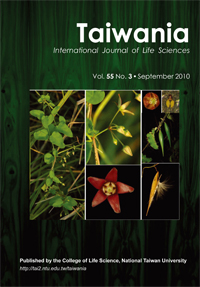Research Paper
Macrohabitat Characteristics and Distribution Hotspots of Endemic Bird Species in Taiwan
Chia-Ying Ko, Ruey-Shing Lin and Pei-Fen Lee
Published on: 15 September 2010
Page: 216 - 227
DOI: 10.6165/tai.2010.55(3).216
Abstract
Understanding species distributions is essential for developing biodiversity conservation strategies. We combined two bird inventories conducted from 1993 to 2004 and identified specific features of 17 endemic bird species in Taiwan. We used eight environmental variables, including elevation, annual total precipitation, annual mean temperature, warmth index, percentage of forest cover, mean Normalized Difference Vegetation Index (NDVI), percentage of building area, and road density, to define macrohabitat characteristics of each species. All the data were in a 1 × 1 km gird system. The 17 species were classified as common (being present in more than 200 grids), uncommon (100–200 grids) or rare (less than 100 grids). The Mikado Pheasant (Syrmaticus mikado), as a rare species, had the lowest occurrence records, while the Taiwan Barbet (Megalaima nuchalis), as a common species, had the highest. Each species had a specific distribution range and habitat preference. These 17 species occupied heterogeneous elevation and climatic conditions. In general, they favored habitats with high vegetation cover, at almost full forest cover and median to high NDVI. Canonical correspondence analysis (CCA) indicated that elevation had the highest correlations with species distributions, with axis 1 accounting for 57.5% of the variation and axis 2 for 9.8%. The endemic species in Taiwan could be classified into three groups mainly separated by elevation based on the CCA. Potential biodiversity hotspots, in the elevation range of 300 and 1500 m with 45%-100% forest cover, included 33.2% areas of Taiwan. Only 35% of actual hotspots (grid with the number of endemic species ≧7) were located in the potential hotspots. Most of the actual hotspots (65%) occur at higher elevation than the potential hotspots. These data demonstrated the distribution patterns of the endemic bird species in Taiwan, and topography and vegetation are the most important macrohabitat factors associated with these species.
中文摘要
了解物種分布是用以發展生物多樣性保育經營管理策略的基本要素。本研究結合1993 至2004 年鳥類調查觀察記錄,識別出17 種特有鳥種在臺灣個別與獨特的分布形態。在ㄧ 平方公里的解析度下,利用八個環境因子,包含海拔、年雨量、年均溫、溫量指數、森林 密度、植被指數、建物與道路密度等定義物種的巨棲地特徵。依據物種出現記錄的網格數, 可將此17 種特有鳥種分為普遍種 (具有多於200 個網格的出現記錄)、不普遍種 (100 至200 個網格) 與稀有種 (少於100 個網格) 共三大類型,其中稀有種之一的帝雉 (Syrmaticus mikado) 含有最少的出現記錄,而普遍種之一的五色鳥 (Megalaima nuchalis) 則有最多的發 現記錄。研究結果顯示,各特有種具有其特定的分布範圍以及棲地類型喜好,整體而言, 17 種特有鳥種棲息地乃於相異的海拔與氣候條件下。植被覆蓋度高、森林密度大以及植被 指數中至高的棲地類型普遍為17 種特有鳥種所偏好。於典型對應分析中可發現,海拔與物 種分布相關性最高,其中第一軸的解釋可達57.7%,第二軸解釋力為9.8%,同時特有鳥種 可在此分析下被區分為三個海拔分布族群。植基於典型對應分析的結果,生物多樣性可能 熱點乃坐落在海拔300 至500 公尺與森林密度45%至100%之間,占臺灣總面積約33.2%。 比較生物多樣性實際熱點,即該網格內實際觀察到之物種數高於7 種者,僅35%位於可能 熱點區域內,多數的實際熱點 (65%) 發生於更高海拔處。透過這些資料證實了特有鳥種在 臺灣的分布情形,而地形與植被是為了解物種於巨棲地下分布特徵的重要且高度相關因子。
Keyword: biodiversity inventory, macrohabitat, canonical correspondence analysis, endemic bird species, biodiversity hotspot.


